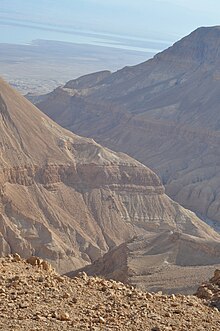Bar Kokhba refuge caves

Bar Kokhba refuge caves are natural caves used for shelter by Jewish refugees during the later phases of the Bar Kokhba revolt. Most of the refuge caves were located in the Judaean Desert, nestled within steep cliffs faraway from settlements, many overlooking the Dead Sea and the Jordan Valley. Some were also found in riverbeds flowing into the Dead Sea, while others were nestled within the Judaean Mountains. Unlike purpose-built hiding complexes constructed by the rebels, the refuge caves remained largely untouched by human intervention.[1]
Jews taking shelter in these caves aimed to escape the Roman army during its suppression of the revolt. Some caves show signs of successful refuge, while others contain skeletal remains of adults and children, indicating deaths due to starvation, thirst, or encounters with Roman forces.[1]
Refuge caves such as the Cave of Letters and Cave of Horror in Nahal Hever, as well as those within Wadi Murabba'at, have yielded many notable archaeological artifacts, including fragments of Biblical scrolls, documents in Aramaic and Greek, weaponry, and coins minted by the Bar Kokhba administration. The caves have also preserved artifacts of daily life, such as metalwork, pottery, glassware, and textiles, offering insights into life during this period and the experiences of the refugees.[2]
Examples[edit]
Wadi Muraba'at caves[edit]
Wadi Murabba'at or Nahal Darga, is a ravine in the northern Judean Desert housing three karstic refuge caves. Excavated in 1952 by Gerald Lankester Harding and Roland de Vaux, the caves yielded textiles, basketry, ropes, and fragments of leather and papyrus inscribed in Aramaic, Hebrew, and Greek. Among the discoveries were biblical texts, a marriage contract, and letters sent by Simon bar Kokhba.[3] A Minor Prophets scroll was found in a small crevice there by a Bedouin a few years later, in 1955.[4]
El-Jai cave[edit]
The El-Jai cave is located in the Nahal Michmas riverbed,[5] in the northern Judaean Desert.[6] In 1997, Eshel and Zissu found 16 coins there, including four minted by the Bar Kokhba administration.[6]
'Aboud cave[edit]
The 'Aboud Cave, situated in the western Benjamin Hills near the modern village of 'Aboud, lies within the eastern-central region of the West Bank. Explored by Boaz Zissu, Boaz Langford, and Amos Frumkin, the site yielded artifacts such as oil lamps, metalwork, glassware, and Bar Kokhba coinage.[7][8]
Other caves[edit]
Other caves include the Nahal Michmas cave, el-Misya, the pool cave at Nahal David, the Nahal Ze'elim cave, 'Araq el-Battan in Nahal Shiloh, Cave of the spear, the Nahal 'Arugot cave, the Nahal Qidron cave, the Mount Yishai cave, the Nahal David caves and the Nahal Makuk caves.
See also[edit]
References[edit]
- ^ a b Eshel, Hanan (2019). "The Refuge Caves". The Bar Kokhba Revolt: The Archaeological Evidence. Jerusalem: Yad Izhak Ben-Zvi. pp. 62–64. ISBN 978-965-217-429-1.
- ^ Zissu, Boaz; Eshel, Hanan (2016-01-01), "Religious Aspects of the Bar Kokhba Revolt: The Founding of Aelia Capitolina on the Ruins of Jerusalem", The Religious Aspects of War in the Ancient Near East, Greece, and Rome, Brill, p. 389, ISBN 978-90-04-32476-3, retrieved 2024-05-02
- ^ Vaux, Father Roland de (2009-01-01), "Chapter 3: Discoveries at Wadi Murabba'at", The Dead Sea Scrolls, A Full History, Brill, pp. 115–129, doi:10.1163/9789004193741_004, ISBN 978-90-04-19374-1, retrieved 2024-05-02
- ^ Eshel, H. (2010). Gleaning of scrolls from the Judean Desert. In The Dead Sea Scrolls (pp. 47-87). Brill.
- ^ Hofman, Miriam Ben Zeev (2019). "Eusebius and Hadrian's Founding of Aelia Capitolina in Jerusalem". Electrum. 26: 120. doi:10.4467/20800909el.19.007.11210. ISSN 1897-3426.
- ^ a b Zissu, Boaz; Eshel, Hanan (2016-01-01), "Religious Aspects of the Bar Kokhba Revolt: The Founding of Aelia Capitolina on the Ruins of Jerusalem", The Religious Aspects of War in the Ancient Near East, Greece, and Rome, Brill, pp. 389–393, ISBN 978-90-04-32476-3, retrieved 2024-05-02
- ^ Jackson-Tal, Ruth E.; Raviv, Dvir; Langford, Boaz; Davidovich, Uri; Frumkin, A.; Porat, Roi; Zissu, Boaz (2020). "Glass Use as a Reflection of Abandonment Processes: The 'Abud Refuge Cave, Roman Judea (133/134 C.E.)". Journal of Glass Studies. 62: 69–82. ISSN 0075-4250. JSTOR 26951073.
- ^ זיסו, בועז; לנגפורד, בועז; פורת, רועי; רביב, דביר; פרומקין, עמוס (2017). "מערת עבוד בימי מרידות היהודים ברומאים - תובנות חדשות לאור ממצאים חדשים וניתוח הממצא הקרמי". In טבגר, אהרון; עמר, זהר (eds.). במעבה ההר [In the Highland's Depth] (in Hebrew). Vol. 7. אוניברסיטת אריאל ומדרשת הרי גופנא. pp. 172–173. ISBN 978-965-91808-0-6.
